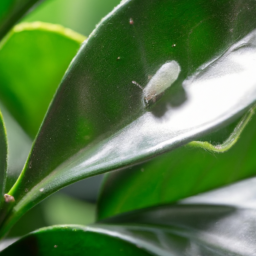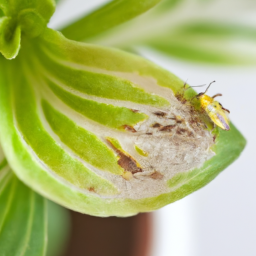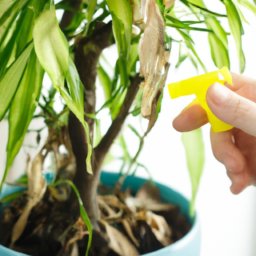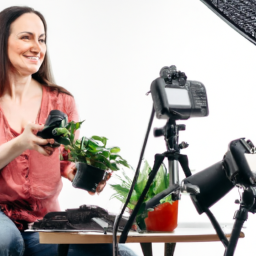
Hey there plant lovers! Are you tired of seeing your indoor plants suffer from mysterious ailments? Well, you’re in luck because today we’re diving into the world of common indoor plant pests: identification and management. Whether you’re a seasoned plant parent or just starting out on your green thumb journey, dealing with pesky critters can be a real challenge. But fear not! In this blog post, we’ll cover everything you need to know about identifying and managing those annoying pests that can wreak havoc on your beloved houseplants. So, let’s roll up our sleeves and get ready to tackle these tiny troublemakers head-on!
Identification of Common Indoor Plant Pests
Introduction
Indoor plants not only bring beauty and freshness to our homes but also provide numerous health benefits. However, just like outdoor plants, indoor plants are susceptible to pests. These tiny invaders can cause significant damage to our beloved plants if left untreated. In this guide, we will explore the most common indoor plant pests, learn how to identify them, and discuss effective management strategies to keep our plants healthy and thriving.
1. Aphids
Aphids are one of the most common indoor plant pests. These tiny, pear-shaped insects can be found in various colors, including green, black, brown, or even pink. You may notice them congregating on the undersides of leaves or along the stems of your plants. Aphids feed by sucking sap from the plant, causing leaves to curl, yellow, or even drop prematurely.
To manage aphids, start by physically removing them from your plants. Use a soft cloth or sponge soaked in soapy water to gently wipe off the insects. Alternatively, you can create a homemade insecticidal soap by mixing a teaspoon of mild liquid soap with a quart of water. Spray this solution on the affected areas, making sure to cover both sides of the leaves. Repeat this process every few days until the aphids are gone.
If the infestation persists, consider introducing natural predators like ladybugs or lacewings to your indoor garden. These beneficial insects feed on aphids and can help control their population. Additionally, regularly inspect your plants for signs of aphids and promptly remove any heavily infested leaves or stems.
2. Spider Mites
Spider mites are tiny arachnids that can wreak havoc on indoor plants. These pests are barely visible to the naked eye and often appear as tiny dots on leaves. Spider mites feed by piercing plant cells and sucking out the contents, leading to stippled, discolored leaves and the presence of fine webbing on the plant’s surface.
To tackle spider mites, start by isolating the infested plant to prevent the pests from spreading to other plants. Increase the humidity around the plant by misting it regularly or placing a tray filled with water nearby. Spider mites thrive in dry conditions, so increasing humidity can help deter their population growth.
Next, thoroughly wash the plant with a strong jet of water, focusing on the undersides of leaves where spider mites often hide. This will help dislodge and remove the pests. For severe infestations, consider using insecticidal soap or neem oil. These organic solutions can be sprayed on the plant, covering all surfaces. Repeat the treatment every few days until the spider mites are eradicated.
3. Fungus Gnats
Fungus gnats are small, dark-colored flies that are commonly found buzzing around indoor plants. These pests lay their eggs in the soil, and the larvae feed on organic matter and plant roots. Over time, this can lead to stunted growth, yellowing leaves, and an overall decline in plant health.
To combat fungus gnats, start by allowing the soil to dry out between waterings. These pests thrive in moist conditions, so reducing watering frequency can help disrupt their life cycle. Additionally, avoid over-fertilizing your plants, as excessive nutrients can attract fungus gnats.
To trap adult fungus gnats, create simple homemade traps. Fill a shallow dish with apple cider vinegar or red wine and add a few drops of dish soap. The gnats will be attracted to the scent and get trapped in the solution. Place these traps near your plants to catch the adult flies.
For larvae control, consider applying a biological control agent called Bacillus thuringiensis israelensis (BTI). This naturally occurring bacterium targets fungus gnat larvae and can be mixed with water and applied to the soil according to the manufacturer’s instructions.
Conclusion
Identifying and managing common indoor plant pests is crucial for maintaining the health and beauty of our indoor gardens. By familiarizing ourselves with the signs of infestation and implementing appropriate management strategies, we can effectively control and prevent the damage caused by aphids, spider mites, and fungus gnats. Remember to regularly inspect your plants, maintain proper plant care practices, and intervene promptly at the first sign of trouble. With a little effort and vigilance, your indoor plants will thrive pest-free, bringing joy and tranquility to your living spaces.

Management Strategies for Indoor Plant Pests
Introduction
Indoor plants not only add beauty and freshness to our homes, but they can also be susceptible to various pests. These pests can cause damage to our beloved plants if left untreated. In this article, we will explore effective management strategies for common indoor plant pests, helping you identify and combat these pesky invaders.
Identifying the Pests
Before diving into the management strategies, it’s crucial to be able to identify the common indoor plant pests. By recognizing the signs and symptoms, you can take appropriate action to protect your plants. Here are some of the most common pests you may encounter:
1. Fungus Gnats: These tiny black flies are often found hovering around the soil surface. The larvae feed on organic matter in the soil, while the adults can cause damage by laying eggs in the soil and on plant leaves.
2. Mealybugs: Mealybugs are small, soft-bodied insects covered in a white, cotton-like substance. They can be found on the leaves, stems, and even the soil of your indoor plants.
3. Spider Mites: Spider mites are tiny pests that are difficult to see with the naked eye. They often leave behind fine webbing on the leaves, and their feeding causes yellowing and stippling on the foliage.
4. Aphids: These small insects can be found in clusters on the undersides of leaves or on new growth. They suck sap from the plant, causing wilting, yellowing, and distorted growth.
5. Scale Insects: Scale insects appear as small, raised bumps on the leaves and stems of plants. They can be brown, black, or even translucent, and they feed on plant sap, causing yellowing and stunted growth.
Management Strategies
Now that you can identify the common indoor plant pests, let’s explore effective management strategies to keep them at bay.
1. Cultural Practices: Implementing good cultural practices can help prevent and manage indoor plant pests. Here are some tips:
– Proper watering: Overwatering can create favorable conditions for pests. Ensure that you water your plants appropriately, allowing the soil to dry out slightly between waterings.
– Regular cleaning: Dust and debris can attract pests. Wipe down the leaves of your plants regularly to keep them clean and free from pests.
– Isolation: If you notice any signs of pests on one of your plants, isolate it from the rest to prevent the infestation from spreading.
– Optimal lighting: Providing adequate light for your plants can promote healthy growth, making them less susceptible to pests.
2. Biological Control: Introducing beneficial insects or organisms that prey on pests can be an effective way to manage indoor plant pests. Some common biological control options include:
– Ladybugs: Ladybugs are natural predators of aphids and can help control their population.
– Parasitic Wasps: These tiny wasps lay their eggs inside the bodies of pests, effectively controlling their numbers.
– Nematodes: Nematodes are microscopic worms that attack the larvae of various pests, including fungus gnats.
3. Mechanical Control: For severe infestations, mechanical control methods can be employed. These methods involve physically removing the pests from the plants. Here are some mechanical control techniques:
– Handpicking: Pick off larger pests, such as mealybugs or scale insects, using tweezers or a cotton swab dipped in rubbing alcohol.
– Pruning: Remove heavily infested plant parts to prevent the spread of pests to healthy areas.
– Washing: Gently wash the leaves and stems of your plants with a mild soap and water solution to remove pests and their eggs.
4. Chemical Control: If all else fails, chemical control methods can be used as a last resort. However, it’s important to exercise caution when using pesticides indoors. Follow these guidelines:
– Choose the right pesticide: Select a pesticide specifically labeled for indoor use and the targeted pest.
– Read and follow the instructions: Carefully read the instructions on the pesticide label and follow them to ensure safe and effective use.
– Apply sparingly: Use pesticides sparingly and only on affected plants, avoiding excessive application.
Conclusion
Managing indoor plant pests requires a combination of identification, prevention, and intervention strategies. By implementing good cultural practices, utilizing biological and mechanical controls, and resorting to chemical control as a last resort, you can effectively manage and protect your indoor plants from common pests. Remember to regularly inspect your plants for signs of infestation and take prompt action to keep your indoor jungle thriving and pest-free.

Preventing and Controlling Indoor Plant Pests
Indoor plants not only add beauty to our homes but also provide numerous health benefits. However, they can sometimes fall prey to pesky pests that can damage their growth and overall health. In this guide, we will discuss the identification and management of common indoor plant pests, as well as effective preventive measures to keep your plants healthy and thriving.
Identifying Common Indoor Plant Pests
Before delving into pest management, it’s crucial to identify the specific pests affecting your indoor plants. Here are some of the most common pests you may encounter:
1. Fungus Gnats: These tiny flying insects are often found around potted plants. They lay their eggs in moist soil, and the larvae feed on organic matter and plant roots, causing damage and stunted growth.
2. Aphids: Aphids are small, soft-bodied insects that can be found on the undersides of leaves. They suck sap from plants, causing yellowing, distorted leaves, and the secretion of sticky honeydew.
3. Mealybugs: Mealybugs are small, white, cotton-like insects that cluster on the stems and leaves of plants. They also feed on plant sap, leading to weakened growth and the development of mold.
4. Spider Mites: Spider mites are tiny pests that often go unnoticed until their webbing becomes visible on the leaves. They suck plant sap, causing yellow spots and eventually leaf drop.
Managing Indoor Plant Pests
Once you have identified the pests infesting your indoor plants, it’s time to take action. Here are some effective management strategies:
1. Manual Removal: For larger pests like mealybugs and aphids, you can manually remove them using a cotton swab dipped in rubbing alcohol or by spraying them with a mixture of water and mild soap. Be sure to cover both sides of the leaves and repeat the process if necessary.
2. Neem Oil: Neem oil is a natural insecticide that can be used to control a wide range of pests. Dilute the oil according to the instructions on the packaging and spray it on the affected plants, focusing on the undersides of leaves. Repeat the application every 7-14 days until the infestation is under control.
3. Biological Controls: Introducing beneficial insects like ladybugs or predatory mites can help control pest populations. Ladybugs feed on aphids, while predatory mites prey on spider mites. These natural enemies can be purchased online or at garden centers and released onto your plants.
4. Quarantine: If you bring home a new plant, it’s essential to quarantine it for a few weeks to ensure it is pest-free. Keep the plant away from your existing indoor plants to prevent any potential infestation from spreading.
5. Proper Watering: Overwatering can create a favorable environment for fungus gnats. Allow the top inch of soil to dry out before watering your plants again. Additionally, avoid leaving standing water in saucers or trays as it can attract pests.
6. Regular Cleaning: Regularly clean your indoor plants by gently wiping the leaves with a damp cloth. This helps remove dust and debris, making it less attractive for pests to settle and reproduce.
Preventing Indoor Plant Pests
Prevention is always better than cure when it comes to indoor plant pests. By following these preventive measures, you can minimize the risk of infestations:
1. Inspect New Plants: Before bringing new plants into your home, carefully inspect them for any signs of pests. Look for webbing, sticky residue, or any visible insects on the leaves and stems.
2. Maintain Optimal Conditions: Indoor plants thrive in specific temperature and humidity ranges. Make sure to provide adequate light, ventilation, and appropriate watering to keep your plants healthy. Healthy plants are less susceptible to pest attacks.
3. Use Clean Potting Soil: When repotting or planting new indoor plants, always use fresh, sterile potting soil. This reduces the chances of introducing pests or diseases into your plant collection.
4. Remove Infested Plants: If you notice severe infestations that are difficult to control, it’s best to remove the affected plant from your indoor space. This prevents the pests from spreading to other plants.
5. Monitor Regularly: Keep a close eye on your indoor plants for any signs of pest activity. Early detection allows for prompt action and increases the chances of successful pest management.
By following these steps for identifying, managing, and preventing indoor plant pests, you can ensure the health and vitality of your beloved indoor plant collection. Remember, a little care and attention go a long way in keeping your plants pest-free and thriving.
Crisp Recap
Indoor plants can bring life and beauty to any space, but they are not immune to pests. These tiny invaders can wreak havoc on your beloved plants if left unchecked. In this blog post, we will discuss some of the most common indoor plant pests, how to identify them, and effective management strategies to keep your plants healthy and thriving.
One of the most notorious indoor plant pests is the spider mite. These minuscule pests can be difficult to spot with the naked eye, but their presence is often indicated by tiny webs on the leaves. Spider mites feed on plant sap, causing yellowing and wilting of the foliage. To manage spider mites, regular inspection is key. If detected early, you can use a gentle insecticidal soap or neem oil spray to control their population. Another common pest is the mealybug, which appears as cotton-like masses on the plant’s stems and leaves. These pests suck the sap out of the plant, leading to stunted growth and yellowing. To combat mealybugs, you can manually remove them with a cotton swab soaked in rubbing alcohol or use a horticultural oil spray for larger infestations. Remember, prevention is always better than cure, so maintaining a clean and well-ventilated environment, along with regular plant inspections, can go a long way in keeping these pests at bay.
FAQ Roundup:
Q1: What are some common indoor plant pests?
A1: Some common indoor plant pests include aphids, spider mites, mealybugs, scale insects, and fungus gnats. These pests can infest your plants and cause damage if not managed properly.
Q2: How can I identify indoor plant pests?
A2: Identifying indoor plant pests can be done by closely examining your plants. Look for signs such as tiny insects, sticky residue, discolored or distorted leaves, webbing, or small flying insects around your plants. You may also notice wilting or stunted growth in infested plants.
Q3: What are some effective ways to manage indoor plant pests?
A3: There are several management techniques you can use to control indoor plant pests. These include regularly inspecting your plants, isolating infested plants to prevent spreading, manually removing pests, using insecticidal soaps or oils, introducing beneficial insects, and maintaining a healthy growing environment for your plants.
Q4: How can I prevent indoor plant pests from infesting my plants?
A4: Preventing indoor plant pests starts with good plant care practices. Ensure your plants receive proper lighting, watering, and fertilization. Avoid overwatering as it can create a favorable environment for pests. Regularly clean your plants and containers, and inspect new plants before bringing them indoors. Quarantine new plants for a few weeks to monitor for any signs of pests.
Q5: Are there any natural remedies to control indoor plant pests?
A5: Yes, there are natural remedies you can use to control indoor plant pests. For example, you can create a homemade insecticidal soap using mild dish soap and water. Neem oil is another effective natural pesticide that can be used against a variety of indoor plant pests. Additionally, introducing beneficial insects like ladybugs or predatory mites can help control pest populations.

Lisa Chen is a seasoned indoor gardening expert and the author of several bestselling books on the topic. With a background in horticulture and urban farming, Lisa is dedicated to helping urban dwellers embrace the joys of cultivating green spaces indoors. Her detailed guides and hands-on tips empower readers to transform their living spaces into thriving plant sanctuaries.


